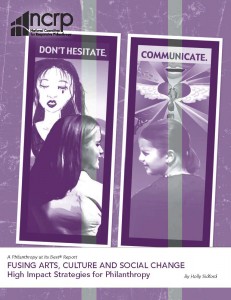Underserved Communities Get 10 Percent Of Arts Grant Money
 By The National Committee For Responsive Philanthropy
By The National Committee For Responsive Philanthropy
America’s dynamic arts and culture landscape continues to evolve along with the changing needs and demographics of our communities. Yet, findings from a new report show that a majority of U.S. foundations that provide financial support to arts and cultural institutions have largely ignored these changes in their giving, according to the National Committee for Responsive Philanthropy (www.ncrp.org).
In “Fusing Arts, Culture and Social Change: High Impact Strategies for Philanthropy,” author Holly Sidford observes that the more a foundation is focused on giving to the arts, the less likely it is to prioritize supporting artistic traditions from Africa, Asia and the Pacific, Latin America, Native American tribal cultures, rural communities and other underserved populations. NCRP is urging arts funders to rethink their practices and consider the benefits of broadening their audience to include underserved communities and supporting arts that promote equity and justice.
Only 10 percent of grant dollars made to support the arts (such as visual arts, performing arts and museums) explicitly benefit the poor, ethnic and racial minorities, the elderly and other marginalized populations. Less than 4 percent of grants dollars support advancing social justice goals through the arts.
Further, 55 percent of arts grants go to organizations with budgets greater than $5 million, which represent less than 2 percent of the more than 100,000 arts and culture nonprofits. Recent research demonstrates that the primary audience of these large institutions is predominantly white and upper-income.
“Culture and the arts are vehicles for expressing our struggles and accomplishments, our identity and hopes for the future as individuals and as a society,” said Sidford, a consultant to cultural organizations and philanthropists. “When philanthropy ignores the breadth of artistic practices taking place today, it ignores large segments of our society and misses the tremendous opportunities to help build and strengthen our communities, fight for justice and protect our democracy.”
“There is a mismatch between the priorities and strategies of foundations that give to the arts and the needs of our communities,” said Aaron Dorfman, executive director of NCRP. “Arts grantmakers need to revisit their policies and practices if they wish to continue to be relevant and increase their effectiveness given the evolving demographic, economic and cultural landscape.”
“Fusing Arts, Culture and Social Change” is available on NCRP’s website at http://www.ncrp.org/paib/arts-culture-philanthropy.
The is a press release from the National Committee For Responsive Philanthropy in Washington, D.C. a national watchdog, research and advocacy organization that promotes philanthropy that serves the public good, is responsive to people and communities with the least wealth and opportunity, and is held accountable to the highest standards of integrity and openness. Visit www.ncrp.org.

